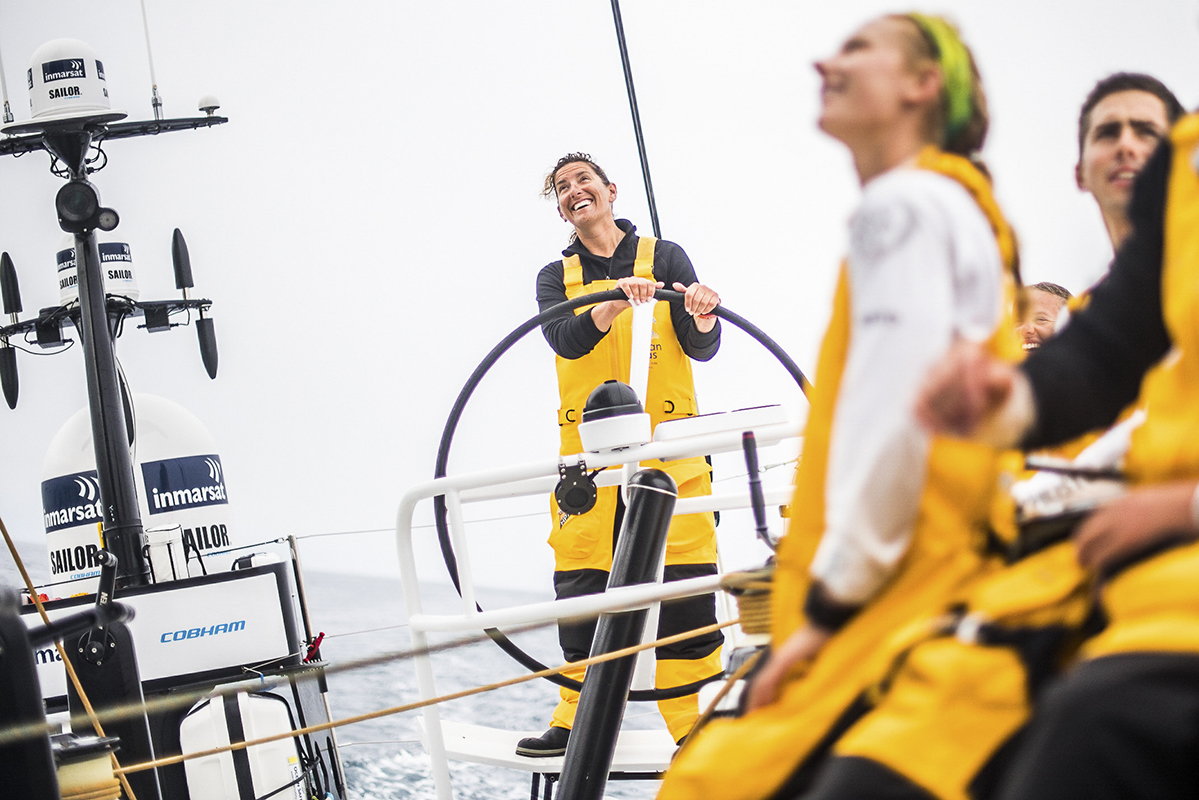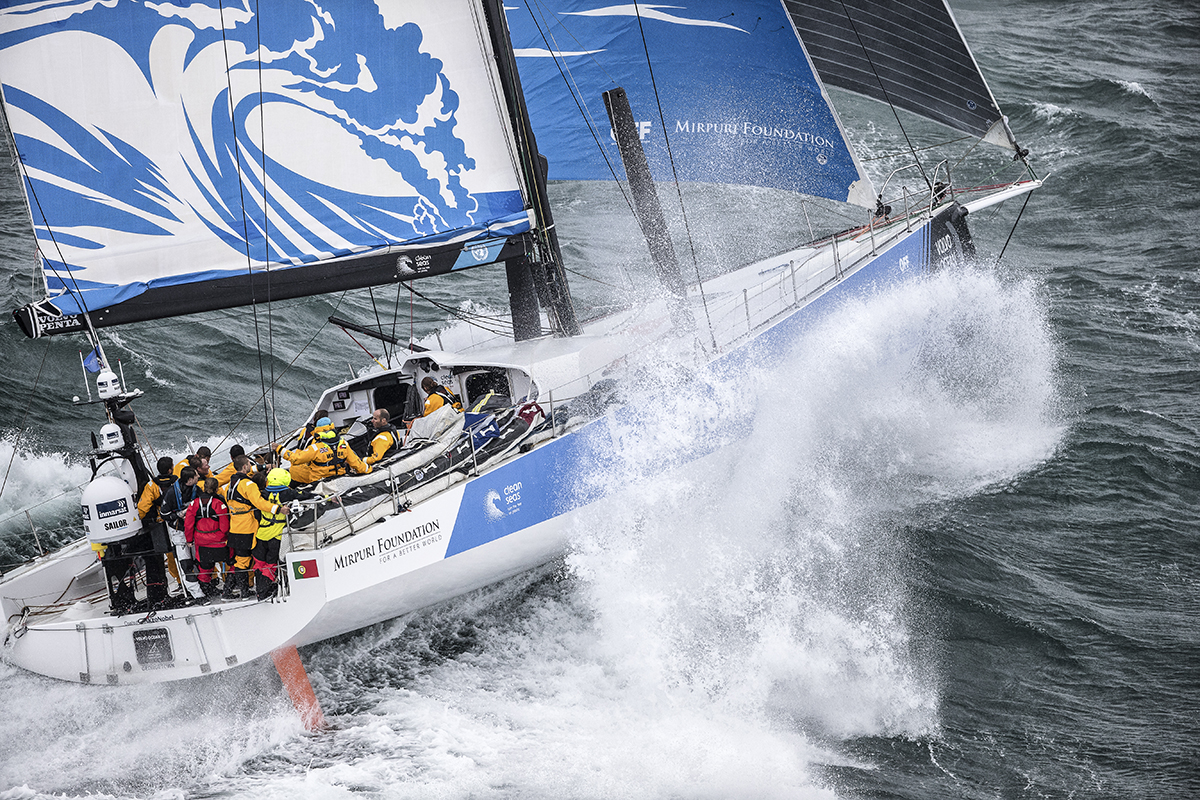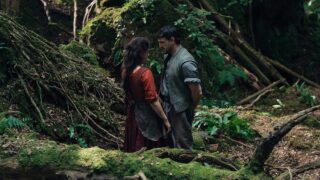This website uses cookies so that we can provide you with the best user experience possible. Cookie information is stored in your browser and performs functions such as recognising you when you return to our website and helping our team to understand which sections of the website you find most interesting and useful.
Record-breaking female sailor Dee Caffari on turning the tide at the Volvo Ocean Race
By Rachel Ingram | 11 September 2017 | Culture, Sport
Sustainability, gender equality, diversity… record-breaking sailor Dee Caffari is battling more than just the waves at this year’s Volvo Ocean Race

She’s sailed around the world an impressive five times and smashed a hoard of ‘female first’ records, but sailor Dee Caffari’s greatest challenge is yet to come. The Volvo Ocean Race is the most testing off shore sailing competition on the planet. In an intense battle of mankind versus the elements, competing teams combat the unpredictable waters of four oceans in an eight-month test of physcial and emotional strength and endurance.
The triennial Volvo Ocean Race, which kicks off in Alicante in October, is her biggest test since completing the Vendée Globe and becoming the first woman to sail solo, non-stop, around the world in both directions. While winning is, obviously, an ambition, Caffari is putting environmental issues front and centre as she takes on the leading role of skipper for the Clean Seas – Turn the Tide on Plastic team, set up by the United Nations. Her hand-selected crew, which also challenges the issues of gender equality and age diversity, might possibly be the most important team the competition has ever seen.
Tempus gets the low-down from Caffari as she takes a break from competing in Leg Zero, the warmup segment of the 2017- 2018 Volvo Ocean Race…
How’s Leg Zero going so far?
It’s alright. We’ve had mixed results but we’re definitely learning every day. We’re a new team that have come quite late into the programme, so it’s nice to have this opportunity to sail with the rest of the fleet and get some tips on what sailing combinations work for us. So far, it’s been really good fun. A lot of the guys we’ve got on board have never sailed in racing boats before, so it’s been quite an interesting learning experience before the big race starts in October.
Can you tell us more about your hand-selected team?
I haven’t actually announced my team yet, beside Liz Wardley, which I only did because everyone was making lots of assumptions. We’re still on trial for a couple more weeks but I’ve got a pretty good idea of my final team. It will be a 50-50 team of five guys and five girls. I’m also trying to run with a youth focus, with 60% of my team under 30.
Why is this important to you?
It’s great to have a sustainability message that is very topical, but it’s also nice to address the issues of gender imbalance, diversity and inclusion by having girls racing alongside guys, which is an environment both Liz and I do most of our sailing in. It’s great that we get to do that while also giving the opportunity for new, younger sailors to step up into the professional world. From my background as a teacher, I like seeing people grow and develop their skills. It’s also lovely to sail with so much energy. When you sail with people who’ve seen it all and done it all, and you don’t get the same level of excitement. It’s easy to forget how lucky we are to do what we do.
Tell us about the environmental campaign that your team is supporting.
We’re racing under the banner of the United Nations Environmental Initiative, Clean Seas – Turn the Tide on Plastic. The campaign is about raising awareness and trying to change people’s behaviour regarding single use plastics. The impact plastic has on our ocean’s health is enormous and it ultimately goes full cycle. It comes down to us eating the fish in the ocean, that are eating the plastic that we put in there. Even if we just get people to reject straws and not buy plastic water bottles but refill reusable ones, we’re half way there.
What’s the worst impact you’ve seen out at sea?
Debris issues are generally weather related, so where the high pressure circulates there’s a lack of movement and the rubbish gets sucked into it. I did the Transpac race this year and there were a few albatrosses along the way. One of the girls, who’s a biologist, said there’s a massive issue with them whereby they nest in the Midway Atoll gyre where all the rubbish is. As the babies grow up, they eat the plastic thinking that it’s food and die really young. They’re really struggling with the population. It is heart-breaking, especially when it’s so simple to make a difference.
How have you been preparing for eight months at sea?
For myself and Liz Wardley it’s not our first time around the world. We’ve done it a few times before so we know what to expect, but we’re aware that we’ve got quite a new, young crew that have no idea what they’re going into, so it’s about us sharing our experiences and advice with them. The bit they’re scared about isn’t the sailing, it’s about surviving the whole year out at sea.
What advice have you been giving them?
Simple things such as eating, sleeping and fitness. Once you start this process, there isn’t time to make a big difference to your fitness. You have to maintain it and be careful. You don’t really want to lose weight because you don’t have the time in the stopovers to put it back on, which has a knock-on effect on the team’s performance. It’s really important that they accept that and make an e ort both now in the preparation period and while we’re racing.

While you’re now part of a team, you’ve done a lot of solo racing. What do you prefer?
There’s definitely merits to both. When you’re on your own, it’s all your fault and there’s no one to hide behind, but this also means the good stuff is also your own doing. It’s nice to have control and be responsible for everything, but what I love about being in a crew is the intensity and the shared responsibility. Everyone’s buying into the same objective and goal. It’s full on all the time and I quite enjoy that focus.
When you were sailing on your own, what motivated you?
The biggest thing for me was not wanting to let people down. A lot of people had invested time, money and support into getting me to the start line and I needed to deliver. On the other hand, I also craved the challenge. I enjoy pushing boundaries and I enjoy putting sceptics at bay and making them think twice.
Starting out as a woman in sailing, did you find that you faced a lot of scepticism?
Oh, for sure. Especially when you’re someone who’s starting off doing what’s considered the ‘wrong way round’ the world first. There were an awful lot of comments made about it but I’m glad I did that first as I probably wouldn’t do it again now.
Why did you first make the decision to sail the ‘wrong way round’ the world?
It was about opportunities. I was a skipper in Sir Chay Blyth’s Global Challenge race and he said it’s only a matter of time before a female would follow in his footsteps and take on what was called ‘the impossible voyage’, and I thought, why shouldn’t that be me? Life is all about opportunities and deciding which ones you grab and which ones you let pass you by.
Read more about Dee Caffari’s incredible journal in Tempus Magazine issue 52, here







